
The Folk from the Wind Wound Isle > Generation B - James Robertson
page 37
Chapter 8 : Generation B - James Robertson
Born 1841 - Died 1905
James was born at Hellister, Shetland on 16 September 1841. As with some of his siblings we have an alternative date recorded and this is 14 October 1841. Named after his paternal grandfather, James was the third surviving child and eldest son of Margaret Henderson and Arthur Robertson.
James was both a fisherman and a sailor before coming to Australia. His grand daughter Margaret Haine tells us he had ‘sailed around the Horn’ on sailing ships several times before he was twenty. Climbing into the rigging he knew ‘one wrong step and I’ll be in hell’. We know for certain that he was a crewmember on the whaling ships ‘Polar Star’ and the ‘Agostina’ in 1858 and 1859, as his name appears in the ships’ records. In the second ship his age is given as nineteen years.1
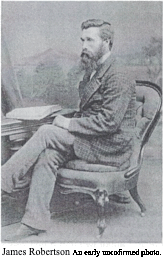 James was the first family member to join Arthur in Australia, arriving in Sydney in 1865. On 1 September 1868, James married Frances Mary HALLS (1848-1924) at Tooliorook, Victoria. Fanny was born at Blaxsall, Suffolk, England on 31 December 1848, the daughter of Edmund Halls and Eliza Abbott. On the marriage certificate James’ occupation is given as stone waller, his father’s as mason and Edmund Halls’ as publican. The ceremony took place in the house of Arthur Robertson (Snr?) at Tooliorook and was conducted by the Rev Sam Corrie, according to the rites of the Church of Scotland. Witnesses were Agnes Robertson and John Lillico (or Sillico?).
James was the first family member to join Arthur in Australia, arriving in Sydney in 1865. On 1 September 1868, James married Frances Mary HALLS (1848-1924) at Tooliorook, Victoria. Fanny was born at Blaxsall, Suffolk, England on 31 December 1848, the daughter of Edmund Halls and Eliza Abbott. On the marriage certificate James’ occupation is given as stone waller, his father’s as mason and Edmund Halls’ as publican. The ceremony took place in the house of Arthur Robertson (Snr?) at Tooliorook and was conducted by the Rev Sam Corrie, according to the rites of the Church of Scotland. Witnesses were Agnes Robertson and John Lillico (or Sillico?).
Margaret Haine understands that Fanny was actually brought up by her grandmother. One of her treasured possessions was a sampler worked by her mother Eliza Abbott at the age of twelve in 1831. This was handed on to Fanny’s daughter Frances and then to Margaret Haine. The sampler, which is in a very frail condition, is now in my custody.
Fanny came to Australia in 1867, believing that in Australia it was possible to pick up gold in the streets. She sailed in the ‘John Temperly’, with James’ siblings, Agnes, Margaret and Arthur. The shipping list records Fanny as servant. She was travelling with two single friends and there are no other Halls listed on the ‘John Temperly’. Fanny became friendly with Agnes and Margaret and decided to accompany them when they joined their family in western Victoria. Her two English friends found employment in Geelong and later married men called Cooper and Wilson.
James and Fanny had five sons and three daughters, John, Abbott Arthur, Frederick, Frances, James Need, William De Witt, Alice and Miriam, born between 1869 and 1887. Alice died as a two year old and John died from pleurisy in 1891 aged twenty-one.
In “Mount Elephant, - a History of Derrinallum and Darlington Districts”, Arthur and James Robertson are listed as trustees for a site of 2 acres to be reserved for a Wesleyan Church in
page 38
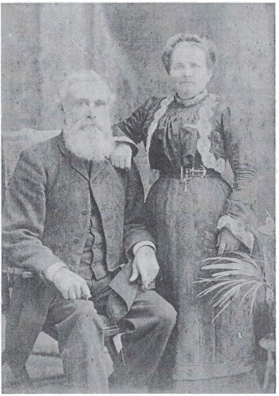 the township of Tooliorook. 2 However the date given for this is 1861 and as Arthur and his son did not arrive in Australia until 1863 and 1865, we must assume that either the 1861 date is incorrect or there was another family of Robertsons with similar names living in the Mt Elephant district. The five house blocks at Derrinallum township registered in the name of J Robertson in 1867, probably belonged to our James Robertson. 3 Neil Saunders wrote in 1976 about having visited Derrinallum in the late 1920s and mentions a “blue stone cottage standing alone. ... It was occupied by an elderly lady who told me that it once belonged to a Mr Robertson who built it for his bride, and who planted the large tree growing in front”. 4
the township of Tooliorook. 2 However the date given for this is 1861 and as Arthur and his son did not arrive in Australia until 1863 and 1865, we must assume that either the 1861 date is incorrect or there was another family of Robertsons with similar names living in the Mt Elephant district. The five house blocks at Derrinallum township registered in the name of J Robertson in 1867, probably belonged to our James Robertson. 3 Neil Saunders wrote in 1976 about having visited Derrinallum in the late 1920s and mentions a “blue stone cottage standing alone. ... It was occupied by an elderly lady who told me that it once belonged to a Mr Robertson who built it for his bride, and who planted the large tree growing in front”. 4
James Robertson and his wife Frances >
The various locations in which his children were born tell us that James never stayed in one place for long. James and Fanny were living at Ellerslie when their fourth child, Frances, was born in 1876. On his daughter’s birth certificate, James is recorded as ‘stonemason’. A year later at Woodford, his son’s birth certificate records him as ’labourer’. Documents in the possession of Margaret Haine indicate that James owned land at Ellerslie, which he sold to a James Need in 1878. Robert Robertson mentions that his brother James conducted revival meetings at Grassmere and Purnim, not far from Ellerslie.
James also took up land at Port Campbell and the official report following the inspection of his land by a mounted constable in 1874 (already quoted in Chapter 6) gives us a clear picture of an early selection. 5 The purpose of the inspection was to assess whether one tenth of the land was suitable for cultivation. James was not in residence at the time, working away from home at Mt Elephant.
The report describes, “A slab hut with bark roof, and slab and stone chimney, 18ft by 10ft, in good repair, erected about two and a half years. A paling fowl house with shingle roof 7ft by 5ft in good repair, erected about two years. About thirteen and a half chains of log and brush fence and about eight and a half chains of rough picket fence in good repair erected about two and a half years. About two acres grubbed and cleared and about six acres cleared by cutting dense scrub and collecting and burning dead timber. The land is very heavily timbered and covered with dense scrub. About 2 acres cultivated - crop potatoes. This area forms part of the land cleared. I consider that one tenth of the land is fit for cultivation”. I believe this land was later transferred to Arthur Robertson Jnr.
At some stage James went to the gold rush in Western Australia, but we do not have a date. In WA he suffered a serious illness, which convinced him that chasing gold was not what he was
page 39
supposed to be doing. He made a bargain with the Lord that if he survived he would return to Victoria to undertake evangelical work. While in the tent hospital in WA, James “had the joy of leading a fellow sufferer to the Cross”.6
In a letter headed ‘Camperdown, 27 August 1889’, James writes to the Rev S Chapman7 about the success of the missionary work he has been conducting. I have retained James’ spelling.
I Baptised 5 at a place called Pumborniet [Pomborneit] And I expect to Baptise 3 more soon. So you see the Lord has been with us. Now I need not tell you I am sorry to give this work up. But I must do so. To do this work I must keep a Horse, and to keep a Horse here meens 10/-s per week, this along with lost time travelling back and forward is more then I can stand out of My Slandar income. So I am fort to Sail My Horse. Now I thought it would be wise to write and let you know, because the placeses I have been holding will soon be fild by other Denomations, if you intend to make a start here Now (it seemes to me) is the time. 8
A second letter, dated 19 November 1889, is to the Rev E Harris and is written from 27 Langridge St, Middle Park, South Melbourne. In this letter James asks for assistance in obtaining a 'responsible position’ as a home missionary.
... I have been working for this last 14 years as home Missioner for our beloved Denominetation But hav never been recognised as such, because I was not payed by your home Misshon, Nor did I want to, because I could soport my salf and do all the work that was to be done in my Nebourhood. But now, as you know, I have come here with my family. The main rason for me doing so is that I may give all my time to Evangelesitek work.
The family was probably still living in Melbourne in 1891, as this is where their eldest son died in March of that year. On John’s death certificate his father’s occupation is given as 'boarding house keeper’. Margaret Haine understands her grandparents had a boarding house in Mildura at one time but cannot give us a date. Possibly it was Fanny who ran the boarding house while James was doing other things such as joining the gold rush in WA or travelling around as a home missionary.
Margaret Haine also told me that James and Fanny sponsored one of Fanny’s relations, possibly her sister, to come to Australia. Fanny made James wear white gloves when they went to meet the ship when it docked in Melbourne. The relation did not like Australia and returned to England. This might have been about 1900. The family was certainly living at Moonee Ponds, a Melbourne suburb, in 1903 when Frances Jnr was married.
By this time James had joined the Evangelical Society and was again serving as a home missionary, travelling extensively around Victoria, preaching and holding open-air meetings.9 While undertaking a mission at Natte Yallock, James contracted influenza, followed by pneumonia. He died at the Methodist parsonage in Avoca, on 23 October 1905 and is buried there.
It is not clear where Fanny lived after James’ death. All her sons had left home, Frances was married and living in Queensland and Miriam also moved to Queensland. This would have left Fanny on her own. She made a trip to visit her relations in England. Neil Saunders writes, “I was 5 years old and treasure two postcards which my grandmother posted to me, one from Ceylon the other from Gibraltar, while she was on a voyage to England in 1908.”10 It seems Fanny’s son, Frederick, paid for the trip after finding a gold nugget in WA. Returning from England, Fanny supported herself by sewing and Margaret Haine thinks she lived with Cairns relations of the Robertsons in Victoria. Margaret remembers her grandmother coming to visit them when her family lived in Nambour.
Fanny accompanied her daughter Frances’ family when they moved to Sheffield, Tasmania after World War I. In Melbourne on the way to Tasmania, Fanny suffered a stroke and on arrival at Davenport she was taken straight to the hospital. She died at Sheffield on 22 July 1924.
page 40
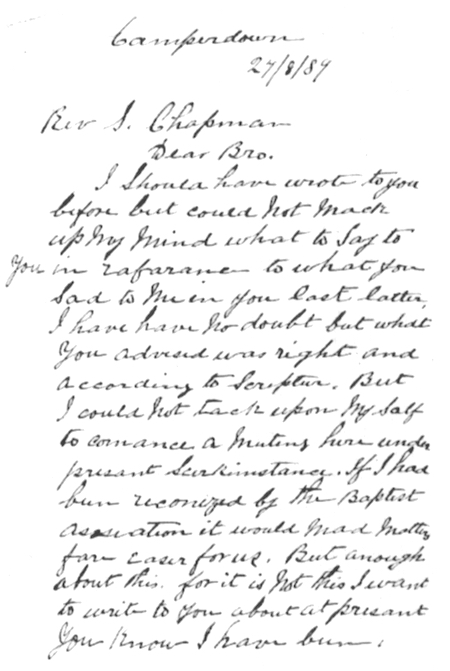

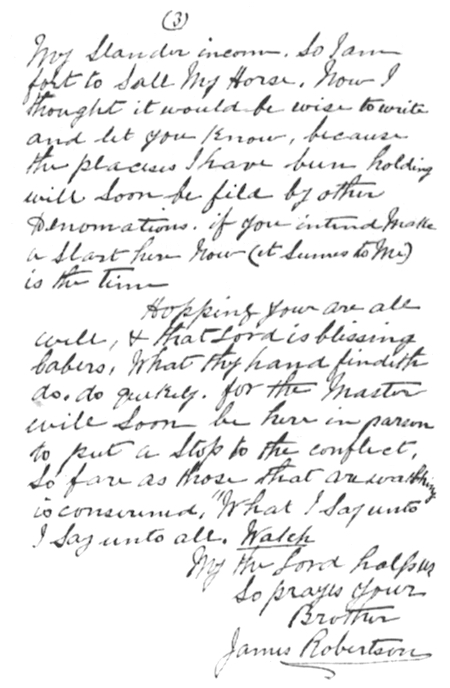
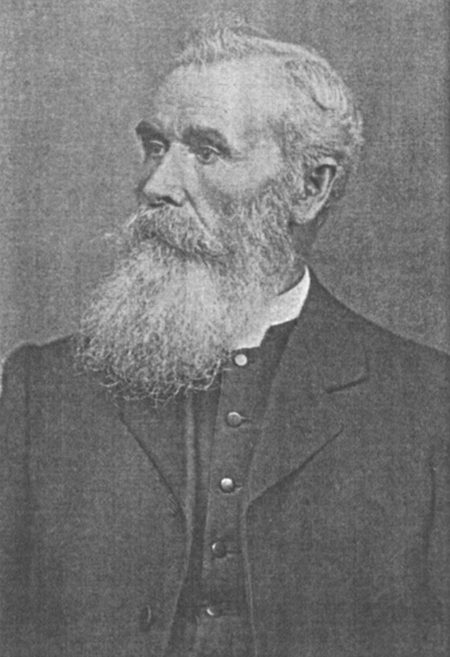
Letter written by James Robertson to the Rev. S Chapman
James Robertson in later life
Notes
1 Shetland Archives
2 P. McGregor and L. Oaten, ‘Mount Elephant - a History of Derrinallum and Darlington Districts’, p.50
3 Section 5 - Lots 5 to 9 - Information obtained by M. Magilton from Victorian Lands Department records
4 Letter from N Saunders to J McCue, 13.4.1976
5 A copy of the report was obtained by M. Magilton from the Public Records Office in Melbourne, it is reproduced in Appendix 4
6 R. Robertson, The Port Campbell Revival’, p.21
7 The Rev Samuel Chapman was Chairman of the Home Missionary Society in Victoria.
8 Copies of the two letters from which I quote were supplied by Matthew Magilton, who found them in the Archives of the Baptist Historical Society while doing research into the life of his relation James Magilton, who was also a Home Missionary
9 The Australian Evangelist’ No 24,24.11.1905
10 Letter from N. Saunders to John McCue, 12.6.1975
Garry Gillard | New: 5 March, 2019 | Now: 5 September, 2022
 James was the first family member to join Arthur in Australia, arriving in Sydney in 1865. On 1 September 1868, James married Frances Mary HALLS (1848-1924) at Tooliorook, Victoria. Fanny was born at Blaxsall, Suffolk, England on 31 December 1848, the daughter of Edmund Halls and Eliza Abbott. On the marriage certificate James’ occupation is given as stone waller, his father’s as mason and Edmund Halls’ as publican. The ceremony took place in the house of Arthur Robertson (Snr?) at Tooliorook and was conducted by the Rev Sam Corrie, according to the rites of the Church of Scotland. Witnesses were Agnes Robertson and John Lillico (or Sillico?).
James was the first family member to join Arthur in Australia, arriving in Sydney in 1865. On 1 September 1868, James married Frances Mary HALLS (1848-1924) at Tooliorook, Victoria. Fanny was born at Blaxsall, Suffolk, England on 31 December 1848, the daughter of Edmund Halls and Eliza Abbott. On the marriage certificate James’ occupation is given as stone waller, his father’s as mason and Edmund Halls’ as publican. The ceremony took place in the house of Arthur Robertson (Snr?) at Tooliorook and was conducted by the Rev Sam Corrie, according to the rites of the Church of Scotland. Witnesses were Agnes Robertson and John Lillico (or Sillico?).
 the township of Tooliorook. 2 However the date given for this is 1861 and as Arthur and his son did not arrive in Australia until 1863 and 1865, we must assume that either the 1861 date is incorrect or there was another family of Robertsons with similar names living in the Mt Elephant district. The five house blocks at Derrinallum township registered in the name of J Robertson in 1867, probably belonged to our James Robertson. 3 Neil Saunders wrote in 1976 about having visited Derrinallum in the late 1920s and mentions a “blue stone cottage standing alone. ... It was occupied by an elderly lady who told me that it once belonged to a Mr Robertson who built it for his bride, and who planted the large tree growing in front”. 4
the township of Tooliorook. 2 However the date given for this is 1861 and as Arthur and his son did not arrive in Australia until 1863 and 1865, we must assume that either the 1861 date is incorrect or there was another family of Robertsons with similar names living in the Mt Elephant district. The five house blocks at Derrinallum township registered in the name of J Robertson in 1867, probably belonged to our James Robertson. 3 Neil Saunders wrote in 1976 about having visited Derrinallum in the late 1920s and mentions a “blue stone cottage standing alone. ... It was occupied by an elderly lady who told me that it once belonged to a Mr Robertson who built it for his bride, and who planted the large tree growing in front”. 4


